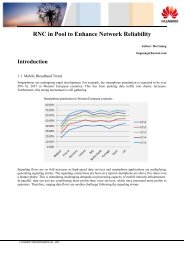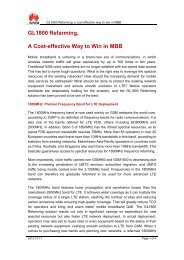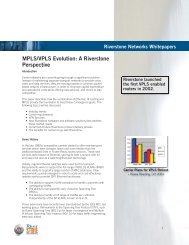The State of Marketing 2010 Unica's Global Survey ... - Light Reading
The State of Marketing 2010 Unica's Global Survey ... - Light Reading
The State of Marketing 2010 Unica's Global Survey ... - Light Reading
You also want an ePaper? Increase the reach of your titles
YUMPU automatically turns print PDFs into web optimized ePapers that Google loves.
<strong>The</strong> <strong>State</strong> <strong>of</strong> <strong>Marketing</strong> <strong>2010</strong><br />
Unica’s <strong>Global</strong> <strong>Survey</strong> <strong>of</strong> Marketers
<strong>2010</strong> is shaping up to be an exciting year for marketers. Unprecedented change, brought on by a volatile economy, the meteoric rise <strong>of</strong> new channels, and the<br />
increased demand for financial accountability, are creating a new era in marketing – one that is more immediate, more personal, more social, and more<br />
engaging. To gain a better understanding <strong>of</strong> the trends in marketing strategy, tactics, and technology usage, Unica partnered with Salloway & Associates, an<br />
independent research company, to survey over 150 online and direct marketers. <strong>The</strong> marketers surveyed:<br />
• represent companies from multiple industries, geographies, and sizes<br />
• span both executive and middle management roles, but are all involved in technology purchase<br />
• have responsibility for a broad set <strong>of</strong> marketing functions that include both online and <strong>of</strong>fline marketing<br />
Here is a snapshot <strong>of</strong> the key findings:<br />
• Challenges & Bottlenecks – Marketers highlight turning data into<br />
actions as one <strong>of</strong> their top issues and see IT as their number one<br />
bottleneck.<br />
• Inbound <strong>Marketing</strong> – <strong>Marketing</strong> is in charge <strong>of</strong> inbound marketing<br />
activities, and nearly three quarters (73%) <strong>of</strong> companies surveyed<br />
are leveraging these customer initiated interactions to serve<br />
marketing messages and <strong>of</strong>fers.<br />
• Centralized Decisioning – Organizational and financial concerns,<br />
rather than technical barriers, are slowing the adoption <strong>of</strong><br />
centralized decisioning. However, it has already been adopted by<br />
some (25%) forward‐looking marketers and is poised for growth<br />
(with 40% saying they have plans to adopt).<br />
• Integrating Online and Offline <strong>Marketing</strong> – Many marketers use<br />
both aggregate web data and <strong>of</strong>fline data when making decisions<br />
about marketing <strong>of</strong>fers. Interestingly, email is the channel where<br />
both online and <strong>of</strong>fline data are most likely to be used in<br />
decisioning. Note the integration <strong>of</strong> online and <strong>of</strong>fline data is<br />
slowed by technical and financial concerns. Based on Unica’s<br />
market experience, the reported high rates <strong>of</strong> online/<strong>of</strong>fline<br />
integration indicate marketers are using aggregate reporting and<br />
web transaction data rather than individual level web behaviors.<br />
• Adoption <strong>of</strong> <strong>Marketing</strong> Technology – Contact optimization and<br />
social media monitoring will be the fastest growing marketing<br />
technologies, while <strong>Marketing</strong> Resource Management (MRM) will<br />
continue to lag. Email marketing, web and customer analytics, and<br />
campaign management are widely adopted, but have varying<br />
maturity. A case in point is the large field <strong>of</strong> email vendors used by<br />
survey respondents – none having more than 10% share – a strong<br />
indicator <strong>of</strong> a highly fragmented, immature market.<br />
• Emerging <strong>Marketing</strong> Channels – Mobile, rich media, and social<br />
media marketing are all being adopted with enthusiasm by<br />
marketers. This adoption is growing both at a fast pace and evenly<br />
across the tactics within each channel.<br />
• Mobile <strong>Marketing</strong> – Continues its march toward greater<br />
significance. A third <strong>of</strong> marketers already conduct some type <strong>of</strong><br />
mobile marketing. For those marketers who have embraced mobile,<br />
the rich interactivity <strong>of</strong> mobile websites and mobile applications is<br />
proving to be an equal draw to text messaging’s reach.<br />
• Social Media <strong>Marketing</strong> – Is embraced by almost half <strong>of</strong> marketers,<br />
and adoption is healthy across most social tactics. However,<br />
marketers need to think more about integrating social media with<br />
other marketing tactics.<br />
Unica Corporation | www.unica.com 2
MARKETING PRACTICES & BUSINESS PROBLEMS<br />
Marketers Struggle with Turning Data into Actions<br />
When asked what issues are important to their success, marketers<br />
responded that everything is important. All answer options scored<br />
between 84% and 97% as being either very important or somewhat<br />
important. Marketers highlight turning data into action as one <strong>of</strong> their<br />
top issues. <strong>The</strong>y also said measuring results & increasing effectiveness<br />
is a very important issue.<br />
Figure 1: <strong>The</strong> Importance <strong>of</strong> Issues to Marketers<br />
Q: How important is each <strong>of</strong> the following issues for your company’s marketing<br />
organization?<br />
Base: Total Sample (155 Respondents)<br />
Marketers See IT as the #1 Bottleneck<br />
While marketers agree that all the survey issues are important, they<br />
express less consensus when asked about bottlenecks in their business.<br />
<strong>The</strong> lack <strong>of</strong> IT support for marketing’s technology needs is the number one<br />
bottleneck; followed by measurement, analysis & learning, and integrating<br />
cross‐channel efforts.<br />
Figure 2: Level <strong>of</strong> Bottleneck Experienced in the <strong>Marketing</strong> Process<br />
Q: How big a bottleneck does your company experience for each <strong>of</strong> the following?<br />
Base: Total Sample (155 Respondents)<br />
Unica Corporation | www.unica.com 3
INTERACTIVE MARKETING<br />
Three Quarters <strong>of</strong> Companies Use Customer Initiated<br />
Interactions as <strong>Marketing</strong> Opportunities<br />
Customer initiated interactions provide an excellent opportunity to<br />
personalize marketing communications. A customer who engages with<br />
your brand by their own choice and shares their wants and needs is much<br />
more receptive to your marketing <strong>of</strong>fers. Almost three quarters (73%) <strong>of</strong><br />
marketers say they currently use targeted/personalized messages in at<br />
least one inbound channel. <strong>The</strong>re is notably more net expected usage in<br />
call centers and on websites than in physical stores/branches. Surprisingly,<br />
there are currently no significant differences by geography, despite Europe<br />
generally being considered more forward thinking in this area. However,<br />
Europeans do say that in the next 12 months they will be more aggressive<br />
in adopting targeting/personalization on websites (30% in Europe versus<br />
13% in North America).<br />
Figure 3: Usage <strong>of</strong> Targeted Messages in Customer Initiated Interactions<br />
Q. In which channels is your company delivering or planning to deliver<br />
targeted/personalized messages during customer initiated interactions?<br />
Base: Total Sample (155 Respondents)<br />
Inbound <strong>Marketing</strong> Predominately Owned by <strong>Marketing</strong><br />
When asked about marketing’s role in customer initiated interactions, only<br />
2% <strong>of</strong> companies said that marketing was not involved. <strong>The</strong>re is a very high<br />
level <strong>of</strong> involvement from marketing in delivering targeted/personalized<br />
messages in inbound marketing with 65% having primary responsibility and<br />
another 32% where marketing assists.<br />
Figure 4: <strong>Marketing</strong>’s Role in Delivering Targeted Messages in Customer<br />
Initiated Interactions<br />
Q. What is marketing’s role in delivering targeted/personalized messages in customer<br />
initiated interactions?<br />
Base: Total Sample Delivering Targeted/Personalized Messages in Customer Initiated<br />
Interactions (113 Respondents)<br />
Unica Corporation | www.unica.com 4
Centralized Decisioning Adopted by Forward‐Looking<br />
Marketers and Poised for Growth<br />
"Centralized Decisioning" technology coordinates outbound and inbound<br />
marketing through a single system maintaining a comprehensive contact<br />
and response history. <strong>The</strong> more marketers can centralize matching<br />
customers to marketing messages and <strong>of</strong>fers, the easier it is to have a well‐<br />
orchestrated dialogue with customers. One quarter <strong>of</strong> marketers are using<br />
centralized decisioning technology. While this is relatively small<br />
penetration, 40% say they plan to adopt it in the future, and more than<br />
half <strong>of</strong> those will adopt in the next 12 months.<br />
In the short term there are no differences across geographies, but longer<br />
term, Europe is more receptive to Centralized Decisioning. 25% <strong>of</strong><br />
European marketers plan to use Centralized Decisioning more than 12<br />
months from now (only 11% <strong>of</strong> North Americans) and 26% <strong>of</strong> North<br />
Americans have no plans (only 13% <strong>of</strong> Europeans).<br />
Figure 5: Company Expected Usage <strong>of</strong> "Centralized Decisioning”<br />
Q. What is your company doing or planning to do with centralized decisioning?<br />
Base: Total Sample (155 Respondents)<br />
Adoption Slowed by Organizational and Financial Concerns<br />
Not Technical Barriers<br />
When asked what prevents marketers from adopting centralized<br />
decisioning, the biggest barriers are:<br />
1. Not being internally ready ‐ e.g. organizational structure, corporate<br />
culture or internal processes<br />
2. Financial barriers ‐ lack <strong>of</strong> budget<br />
Lack <strong>of</strong> budget was selected as a barrier by almost all European<br />
respondents (86%) and on a wide basis among North America respondents<br />
(69%). Not too surprisingly, non‐marketing executives see the lack <strong>of</strong><br />
executive sponsorship as a major barrier; whereas the executives<br />
themselves don’t have this problem.<br />
Figure 6: Ranking <strong>of</strong> the Top 3 Potential Barriers to Achieve<br />
"Centralized Decisioning”<br />
Q. What are your biggest barriers to adopting centralized decisioning?<br />
Base: Total Sample Answering Familiar with the Concept, Know What Company Is Doing<br />
in This Area AND Rated Item as Being a Barrier (114 Respondents)<br />
Unica Corporation | www.unica.com 5
Many Marketers Use Web Data When Making Decisions about Offers<br />
For years marketers have been using demographics and transactional data<br />
to segment customers and improve campaign results. Website data<br />
represents a tremendous opportunity to complement this with<br />
information about customer interests, intent, and behavior. A very high<br />
proportion <strong>of</strong> respondents (75%) use this data when making decisions<br />
about marketing <strong>of</strong>fers.<br />
Figure 7: Use <strong>of</strong> Online Data when Making Decisions about<br />
<strong>Marketing</strong> Offers<br />
Q. Is your company currently using or planning to use data about your online visitors and<br />
their behavior on your website when making decisions about marketing <strong>of</strong>fers?<br />
Base: Total Sample (155 Respondents)<br />
Current use <strong>of</strong> online visitor data is already widespread in email, direct<br />
mail, and web <strong>of</strong>fers. Moreover, in the next year, many expect it to be<br />
used in making decisions about marketing <strong>of</strong>fers across all marketing<br />
channels (expected channel use ranging from 51%‐92%). <strong>The</strong> biggest<br />
growth will come from web, call center, and mobile <strong>of</strong>fers in particular.<br />
Based on Unica’s market experience, the reported high rates <strong>of</strong><br />
online/<strong>of</strong>fline integration indicate marketers are using aggregate analysis<br />
and web transaction data. As their use <strong>of</strong> web data matures, they will<br />
transition to individual customer analysis and web behavior.<br />
Figure 8: Use <strong>of</strong> Online Data when Making <strong>Marketing</strong> Decisions about<br />
<strong>Marketing</strong> Offers by Channel<br />
Q. In which <strong>of</strong> the following channels is your company using or planning to use data<br />
about your online visitors and their behavior on your site when making decisions about<br />
marketing <strong>of</strong>fers?<br />
Base: Total Answering Currently Using or Planning to Use Online Visitor Data when Making<br />
<strong>Marketing</strong> Offers (116 Respondents)<br />
Unica Corporation | www.unica.com 6
Marketers Maintain Use <strong>of</strong> Offline Data in Offer Decisioning<br />
Given the seismic shift in marketing caused by the Internet, it’s interesting<br />
to understand the impact on the use <strong>of</strong> traditional <strong>of</strong>fline data in<br />
marketing. Respondents report high usage <strong>of</strong> integrated <strong>of</strong>fline data in<br />
<strong>of</strong>fer decisioning (similar to their high use <strong>of</strong> online data).<br />
Figure 9: Use <strong>of</strong> Offline Data when Making Decisions about<br />
<strong>Marketing</strong> Offers<br />
Q. Is your company currently using or planning to use <strong>of</strong>fline data when making<br />
decisions about marketing <strong>of</strong>fers?<br />
Base: Total Sample (155 Respondents)<br />
Email Is the Channel where Both Online and Offline Data Are<br />
Most Likely Used in Decisioning<br />
Offline data, like online data, is used consistently across all marketing<br />
channels. Interestingly, email is the channel where both online and <strong>of</strong>fline<br />
data are most likely to be used in decisioning – it even ties direct mail for<br />
<strong>of</strong>fline use!<br />
Figure 10: Use <strong>of</strong> Offline Data When Making Decisions about <strong>Marketing</strong><br />
Offers by Channel<br />
Q. In which <strong>of</strong> the following channels is your company using or planning to use <strong>of</strong>fline data<br />
when making decisions about marketing <strong>of</strong>fers?<br />
Base: Total Answering Currently Using or Planning to Use Online Visitor Data when Making<br />
<strong>Marketing</strong> Offers (116 Respondents)<br />
Unica Corporation | www.unica.com 7
Integrating Online & Offline Data Is Slowed by Technical and Financial Concerns<br />
Companies face a multitude <strong>of</strong> problems when it comes to integrating their online and <strong>of</strong>fline channels. Like centralized decisioning, financial concerns bubble<br />
to the top <strong>of</strong> the list – both lack <strong>of</strong> budget and uncertain ROI. <strong>The</strong> one major difference is “not being internally ready,” which ranked as a lower barrier here<br />
versus centralized decisioning. When ranking top barriers, all <strong>of</strong> them surfaced on a wide scale basis (50%+ ranking all barriers as a top 3 barrier). <strong>The</strong>re was<br />
also a difference in responses geographically. Essentially all European respondents (90%) ranked lack <strong>of</strong> budget as a top barrier, compared to a much smaller<br />
percentage <strong>of</strong> North American respondents (62%).<br />
Figure 11: Ranking <strong>of</strong> the Top 3 Barriers to Integrating Online & Offline Data<br />
Q. What are your biggest barriers for integrating online and <strong>of</strong>fline data?<br />
Base: Total Sample Currently Using or Planning to Use Offline Data when Making <strong>Marketing</strong> Offers AND Rated Item as Being a Barrier (106 Respondents)<br />
Unica Corporation | www.unica.com 8
Marketers Need to Coordinate Online <strong>Marketing</strong> with Other <strong>Marketing</strong> Functions<br />
Surprisingly, only half <strong>of</strong> online marketing functions report into a centralized corporate marketing organization. Another one‐in‐five report into eCommerce.<br />
<strong>The</strong> remainder is evenly spread in small amounts across a variety <strong>of</strong> areas within the organization – an executive <strong>of</strong>fice (e.g., reports directly to CEO or COO);<br />
centralized service organization where they provide services to the business line owners; decentralized reporting within the line <strong>of</strong> business; or in some other<br />
way. When marketing does not own online channels, they must be vigilant about maintaining influence, visibility, and coordination over marketing activities in<br />
these channels.<br />
Even though online marketing doesn’t always report into one marketing organization, it is still reasonably well aligned with the direct marketing function,<br />
either reporting into the same marketing organization (62%) or reporting into separate marketing organizations, and is dotted line/matrix‐managed with each<br />
other (21%).<br />
Figure 12: Reporting Structure <strong>of</strong> Online <strong>Marketing</strong><br />
Q. Into which department does online marketing department report?<br />
Base: Total Sample (155 Respondents)<br />
Figure 13: <strong>The</strong> Organization <strong>of</strong> Direct & Online <strong>Marketing</strong><br />
Q. How are direct marketing and online marketing organized within your company?<br />
Base: Total Sample (155 Respondents)<br />
Unica Corporation | www.unica.com 9
ADOPTION OF MARKETING TECHNOLOGY<br />
Email <strong>Marketing</strong>, Web & Customer Analytics, and Campaign<br />
Management Widely Adopted, with Varying Maturity<br />
Email marketing, web analytics, customer analytics, and campaign<br />
management are expected to be the most widely used categories <strong>of</strong><br />
marketing s<strong>of</strong>tware in the next 12 months (78%‐86% expected use for each<br />
<strong>of</strong> these categories over the next year). However, other questions reveal<br />
that despite similar adoption rates and widespread usage, these<br />
technologies have dramatically different levels <strong>of</strong> maturity. Over half (58%)<br />
<strong>of</strong> web analytics adoption consists <strong>of</strong> free tools like Google Analytics and<br />
Yahoo Analytics (although sometimes in combination with paid tools).<br />
Furthermore, email marketing s<strong>of</strong>tware is fragmented across many<br />
different vendors. Nine different vendors had 7% to 10% adoption, but no<br />
email vendor has more than 10% adoption. <strong>The</strong>se facts highlight the<br />
relative immaturity <strong>of</strong> both web analytics and email markets.<br />
Contact Optimization and Social Media Monitoring Are<br />
Growth Winners, while MRM Lags<br />
When looking more broadly across additional marketing technology<br />
categories, no new categories surface as adoption winners. However,<br />
contact optimization (25% growth) and social media monitoring (21%<br />
growth) will be the highest growth categories in the next 12 months.<br />
<strong>The</strong> lowest rates <strong>of</strong> technology adoption are in the tactical and process<br />
focused areas: marketing resource management (MRM); marketing mix<br />
optimization; marketing financial management; marketing asset<br />
management; distributed/field marketing; public relations management;<br />
event detection; and event management (39%‐48% current and expected<br />
use for each <strong>of</strong> these categories).<br />
Figure 14: Current and Expected Usage by S<strong>of</strong>tware Category<br />
Q. Which <strong>of</strong> the following marketing s<strong>of</strong>tware categories does your<br />
company currently use or is planning to use?<br />
Base: Total Sample (155 Respondents)<br />
Unica Corporation | www.unica.com 10
EMERGING MARKETING CHANNELS<br />
Marketers Adopt Emerging Channels with Enthusiasm<br />
<strong>The</strong> Internet combined with broad consumer adoption <strong>of</strong> mobile, social,<br />
and rich media technologies has set in motion a chain reaction in the<br />
fragmentation <strong>of</strong> media and the proliferation <strong>of</strong> marketing channels. <strong>The</strong><br />
list <strong>of</strong> emerging marketing channels continues to grow at an astounding<br />
pace. A very high proportion (84%) <strong>of</strong> marketers said that they plan to<br />
leverage at least one emerging marketing tactic (rich media, mobile<br />
marketing, or social media) in the next year.<br />
Figure 15: Current or Planned Use <strong>of</strong> Emerging <strong>Marketing</strong> Tactics<br />
Q. Are you currently using or planning to use any emerging marketing tactics (e.g.<br />
mobile marketing, rich media marketing, or social media marketing)?<br />
Base: Total Sample (155 Respondents)<br />
High use <strong>of</strong> all the emerging technologies is expected in the next 12<br />
months: social media marketing (e.g., Facebook: 70%); rich media<br />
marketing (e.g., video or podcasts: 67%); and mobile marketing (e.g.,<br />
mobile websites or mobile applications: 57%).<br />
Figure 16: Usage <strong>of</strong> Emerging <strong>Marketing</strong> Tactics<br />
Q. Which <strong>of</strong> the following marketing tactics is your company currently using or planning<br />
to use?<br />
Base: Total Sample (155 Respondents)<br />
Unica Corporation | www.unica.com 11
Mobile Marches toward Greater Significance<br />
<strong>The</strong> tremendous success and buzz around Apple’s iPhone and Google’s<br />
Android have caused interest in mobile marketing to explode. Given the<br />
combination <strong>of</strong> new devices, faster networks and new location‐aware<br />
technology, mobile will continue its steady march toward greater<br />
significance. In fact, one third <strong>of</strong> marketers (33%) are already conducting<br />
some type <strong>of</strong> mobile marketing. As expected, adoption is slightly higher in<br />
Europe (37%) when compared to North America (29%).<br />
Figure 17: Marketers’ Adoption <strong>of</strong> Mobile <strong>Marketing</strong><br />
Q. Is your company currently using or planning to use mobile marketing tactics (e.g.<br />
mobile messaging, mobile applications, or mobile websites)?<br />
Base: Total Sample (155 Respondents)<br />
<strong>The</strong> Rich Interactivity <strong>of</strong> Mobile Websites and Applications<br />
Is Proving an Equal Draw to SMS’s Reach<br />
Mobile adoption is increasing worldwide, with anticipated very high year‐<br />
over‐year growth in the 30%+ range – across all mobile marketing tactics.<br />
Furthermore, usage <strong>of</strong> these tactics is expected to double in this time<br />
period: 75% expected use for SMS/MMS/WAP campaigns; 66% expected<br />
use for mobile websites; and 63% expected use for mobile applications.<br />
For those marketers already conducting mobile marketing, what’s<br />
surprising is that adoption is relatively even across the different tactics –<br />
despite SMS’s broader reach. For those marketers who have embraced<br />
mobile, the rich interactivity <strong>of</strong> mobile websites and mobile applications is<br />
proving to be an equal draw to SMS’s reach.<br />
Figure 18: Marketers’ Use <strong>of</strong> Specific Mobile Channels<br />
Q. Which <strong>of</strong> the following mobile marketing tactics is your company planning to use?<br />
Base: Total Sample Who Currently Use or Plan to Use Mobile <strong>Marketing</strong><br />
(107 Respondents)<br />
Unica Corporation | www.unica.com 12
Press Play: Video Dominates Rich Media Investments<br />
It’s not a great leap to posit that Google’s acquisition <strong>of</strong> YouTube in 2006 set in motion the dominance video enjoys today as the most adopted rich media<br />
marketing tactic. Videos created by marketing (75%) rank first, followed by streaming media (61%); YouTube (61%); podcasts (55%); and ads within online<br />
videos (48%) are the rich media tactics expected to be used most in the coming year. Year‐over‐year growth in the next 12 months for all these tactics is<br />
expected to be in the 20% range.<br />
Expected use in the next 12 months is significantly lower for in‐game ads/product placements (28%), virtual worlds (26%) and advergames (26%). Year‐over‐<br />
year growth in these tactics is only in the 10% range.<br />
Figure 19: Marketers’ Use <strong>of</strong> Specific Rich Media Channels<br />
Q. Which <strong>of</strong> the following rich media marketing tactics is your company planning to use?<br />
Base: Total Sample That Currently or Plans to Use Rich Media <strong>Marketing</strong> in the Next 12 Months (125 Respondents)<br />
Unica Corporation | www.unica.com 13
Almost Half <strong>of</strong> Marketers Embrace Social Media Today<br />
Sites like Facebook and Twitter have had a meteoric rise. <strong>The</strong>se channels<br />
are not only used by hundreds <strong>of</strong> millions <strong>of</strong> people but also put immense<br />
power in the hands <strong>of</strong> consumers. Blogs, product reviews, and other social<br />
media are mixed with your marketing messages to shape consumers’<br />
perceptions <strong>of</strong> your brand. <strong>The</strong> mass adoption <strong>of</strong> social media has created<br />
anguish for most marketers. However, despite this distress, almost half <strong>of</strong><br />
the marketers surveyed (47%) currently use social media for marketing,<br />
and nearly another quarter (23%) plan to use it in the next 12 months.<br />
Figure 20: Current and Planned Usage <strong>of</strong> Social Media <strong>Marketing</strong><br />
Q. Is your company currently using or planning to use social media marketing tactics<br />
(e.g., Blogs, Facebook, User Communities)?<br />
Base: Total Sample (155 Respondents)<br />
However, the adoption differs dramatically by geography. Europeans<br />
appear more tentative. More marketers in North America (58%) than<br />
Europe (34%) currently use social media marketing. Europeans are<br />
expected to catch up as their adoption speeds up this year (30% expected<br />
growth versus North America’s 18%). Nevertheless, many more in Europe<br />
remain on the sidelines altogether (20%) with no plans to use social media.<br />
Figure 21: Social <strong>Marketing</strong> Usage by Geography<br />
Q. Is your company currently using or planning to use social media marketing tactics<br />
(e.g., Blogs, Facebook, User Communities)?<br />
Base: Total Sample (155 Respondents)<br />
Unica Corporation | www.unica.com 14
Adoption is Healthy across Tactics for Social Media <strong>Marketing</strong><br />
When asked about specific social media marketing tactics, there is high expected usage across most tactics. Third party social networking sites, like Facebook<br />
and MySpace, as well as blogs are mainstays in the marketing mix.<br />
While marketers rely heavily on these proven channels, they embrace Microblogging sites like Twitter, a newer tactic that, not surprisingly, sees strong growth.<br />
Results also indicate noteworthy growth this year in social tactics that help marketers leverage consumers to extend the reach <strong>of</strong> their brands and reinforce<br />
their messages (Viral Content/Word <strong>of</strong> Mouth, User Generated Content, and Voting Features/Product Reviews).<br />
Figure 22: Social Media <strong>Marketing</strong> Tactics Currently or Plan to Use<br />
Q. Which <strong>of</strong> the following social media marketing tactics is your company planning to use?<br />
Base: Total Sample That Currently Uses or Plans to Use Social Media <strong>Marketing</strong> (125 Respondents)<br />
Unica Corporation | www.unica.com 15
Marketers’ To Do List: Integrating Social Media with Other <strong>Marketing</strong> Tactics<br />
Marketers were also asked if they run social media programs as part <strong>of</strong> integrated campaigns, siloed and discrete from other campaigns, or on ad‐hoc basis.<br />
Often emerging channels are not well integrated with existing marketing campaigns. Surprisingly, more marketers say they are trying to integrate these<br />
campaigns with other marketing campaigns/programs, although this does vary significantly by channel. <strong>The</strong> most widely integrated tactics are voting<br />
features/product reviews, user‐generated content, and RSS feeds. Marketers are primarily integrating social campaigns in terms <strong>of</strong> timing, creative themes and<br />
branding. As marketers expand their efforts to promote their brands, they should start to leverage integrated analysis and customer awareness, campaign<br />
decisioning, and marketing execution to make the most effective use <strong>of</strong> social media.<br />
Figure 23: Social Media Tactics that Marketers Integrate with Other <strong>Marketing</strong> Campaigns/Programs<br />
Q. How integrated are the following social media tactics with other company marketing campaigns and programs?<br />
Base: Respondents Who Currently Use Social Media <strong>Marketing</strong> (32‐68 Respondents)<br />
Unica Corporation | www.unica.com 16
RESPONDENT PROFILES<br />
Respondents Include a Wide Range <strong>of</strong> Industries, Geographies, and Sizes<br />
<strong>The</strong> online and direct marketers that responded to the survey represent a wide range <strong>of</strong> industries. <strong>The</strong>re are slightly more respondents from North America<br />
(54%) than from Europe (46%). Also, slightly more than half are from large companies that are above $1B+ in revenue.<br />
Figure 24: Respondents by Industries, Geography, and Revenue<br />
Figure 24‐1: Respondents by Industry<br />
Base: Total Sample (155 Respondents) Online and Direct Marketers<br />
Figure 24‐2: Respondents by Geography<br />
Figure 24‐3: Respondents by Revenue<br />
Unica Corporation | www.unica.com 17
More than One Third Are <strong>Marketing</strong> Executives, and<br />
All Are Involved in the Purchase Process<br />
Figure 25: Respondents by Role<br />
Figure 25‐1: Role in the Organization<br />
Figure 25‐2: Role in the Purchase <strong>of</strong> Technology<br />
Base: Total Sample (155 Respondents)<br />
Respondents Are Responsible for a Broad Set <strong>of</strong> <strong>Marketing</strong><br />
Functions that Span Online & Offline <strong>Marketing</strong><br />
Figure 26: Respondents’ Responsibilities<br />
Table 26‐1: Responsibility by <strong>Marketing</strong> Function<br />
Percent Function<br />
54% Email <strong>Marketing</strong><br />
53% Direct or Database <strong>Marketing</strong><br />
48% Customer Insight or Analysis<br />
45% <strong>Marketing</strong> Operations<br />
35% Web Analytics<br />
35% Cross‐Channel Customer Experience Management<br />
30% Online Customer Experience<br />
28% Online Advertising<br />
25% Event Management<br />
23% Search Engine <strong>Marketing</strong> (SEO, PPC)<br />
21% Field or Channel <strong>Marketing</strong>, Sales Support, and/or Trade Promotions<br />
14% Corporate Communications and/or Public Relations<br />
7% All <strong>Marketing</strong> Functions<br />
Figure 26‐2: Responsibility by Channel<br />
Unica Corporation | www.unica.com 18
SURVEY METHODOLOGY<br />
Unica <strong>Global</strong> <strong>Marketing</strong> <strong>Survey</strong> was fielded to over 150 online and direct marketing pr<strong>of</strong>essionals.<br />
Online surveys were completed in Q4 2009 within 2 geographic regions among Unica customers and prospective customers.<br />
North America represents respondents from the U.S. & Canada. Europe represents respondents from 12 European countries that are large technology<br />
markets.<br />
<strong>The</strong> average survey response time was 16 minutes.<br />
All respondents were rigorously screened to ensure participation by the right respondents within the right companies according to the screening<br />
requirements below:<br />
Responsible for at least one targeted marketing function: all marketing functions; cross‐channel customer experience management; customer<br />
insight or analysis; direct or database marketing; email marketing; field or channel marketing, sales support, and/or trade promotions; marketing<br />
operations; online advertising; search engine marketing (SEO, PPC); web analytics; or online customer experience.<br />
Involved in the purchase process for marketing s<strong>of</strong>tware.<br />
Work for companies with annual revenues <strong>of</strong> US$250M+ to represent mid‐size and large company markets. <strong>Survey</strong>s were conducted among very<br />
large, large, and mid‐size companies.<br />
Sample sources for the study include: large research panels that are representative <strong>of</strong> the target market audiences for the study and Unica supplied<br />
sample <strong>of</strong> customers and prospects from their internal resources.<br />
All surveys were conducted in English.<br />
<strong>The</strong> incidence <strong>of</strong> the random research panel samples was 9% and, for Unica supplied samples, it was 49%. Incidence represents the number <strong>of</strong> people<br />
reached that qualified to participate in the research.<br />
To encourage study participation, Unica disclosed its sponsorship and <strong>of</strong>fered respondents who completed a survey a copy <strong>of</strong> the survey results.<br />
<strong>The</strong> margin <strong>of</strong> error for this sample at the 90% confidence level with a 50% response is +7%.<br />
Unica Corporation | www.unica.com 19
About Unica<br />
Unica Corporation (NASDAQ: UNCA) is the recognized leader in marketing s<strong>of</strong>tware solutions. Unica’s<br />
advanced set <strong>of</strong> enterprise marketing management and on‐demand marketing solutions empowers<br />
organizations and individuals to turn their passion for marketing into valuable customer relationships and<br />
more pr<strong>of</strong>itable, timely, and measurable business outcomes. <strong>The</strong>se solutions integrate and streamline all<br />
aspects <strong>of</strong> online and <strong>of</strong>fline marketing. Unica’s unique interactive marketing approach incorporates<br />
customer analytics and web analytics, centralized decisioning, cross‐channel execution, and integrated<br />
marketing operations. More than 1,000 organizations worldwide depend on Unica for their marketing<br />
management solutions.<br />
Unica is headquartered in Waltham, Massachusetts with <strong>of</strong>fices around the globe.<br />
For more information, visit www.unica.com.<br />
Unica Corporation<br />
Worldwide Headquarters<br />
Reservoir Place North<br />
170 Tracer Lane<br />
Waltham, MA 02451<br />
USA<br />
T +1.781.839.8000<br />
F +1.781.890.0012<br />
E unica@unica.com<br />
www.unica.com<br />
Unica is a registered trademark <strong>of</strong> Unica Corporation with the U.S.<br />
Patent and Trademark Office. <strong>The</strong> Unica logo and MARKETING<br />
SUCCESS STARTS WITH U are trademarks <strong>of</strong> Unica Corporation. All<br />
other trademarks are the property <strong>of</strong> their respective owners.<br />
© <strong>2010</strong> Unica Corporation. All rights reserved.
















